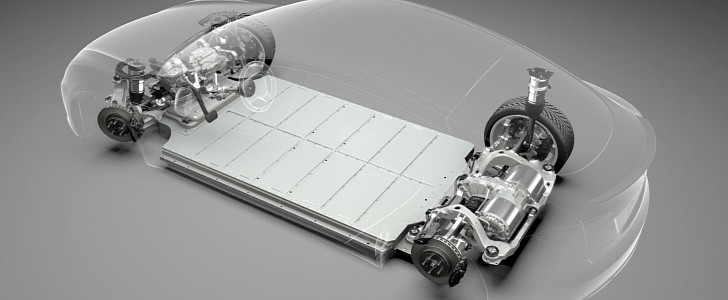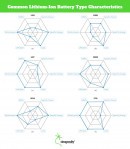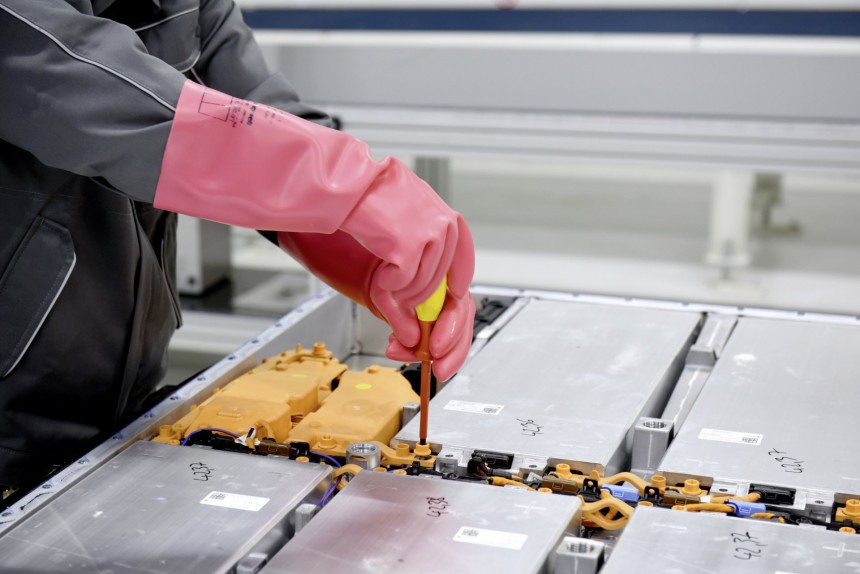Lithium batteries power all our electronic devices, from toys to cellphones and laptops, and all the way up to cars and whole buildings or even cities. Their advantages are indisputable, being energy-dense and durable, but they can also be unstable and prone to catching fire in certain circumstances. We break down the most common types used today and also explain why not all of them are suitable for use in electric vehicles.
When we’re talking about Li-Ion batteries we often seem to imply they are all the same, although they’re not. This is one of the reasons the Li-Ion batteries in phone cells are junk after only three years but the ones in electric cars can go strong for more than a decade. Either type, they function pretty much the same.
Lithium ions store the energy by creating an electric potential difference between the negative and positive poles of the battery. Those are isolated using a separator material to prevent internal discharge. Although it blocks the electrons, the separator allows the lithium ions to pass through. When the battery is charged, the ions move from the positive side to the negative one through the separator. When you discharge the battery, the ions move in the opposite direction.
Those are also known as LFP and use phosphate as the cathode material and a graphitic carbon electrode as the anode. They have long life cycles and good thermal stability, as well as electromechanical performance, but they have low specific energy. Their nominal voltage is high, at 3.2-volt, so connecting four cells will result in a very convenient 12.8-volt battery. That’s why LFP chemistry is best for replacing lead-acid deep cycle batteries in various applications. They can also be very good in electric vehicles, as Tesla already proved.
Lithium Cobalt Oxide (LCO) batteries have high specific energy but low specific power, which means they are good for low power devices, such as portable electronics, phones, and laptops. Safety is a concern and that’s why they lose in popularity to other chemistries. They also have a short lifespan, while cobalt is very expensive.
Lithium Manganese Oxide (LMO) batteries use lithium manganese oxide as the cathode material, resulting in a three-dimensional structure of the cathode. This improves ion flow, with added benefits of higher current handling and improved thermal stability and safety. LMO batteries charge quickly and offer high specific power, making them ideal for power tools and even some hybrid and electric vehicles. The main drawback is the very short lifespan – they only last 300-700 charge cycles.
Lithium nickel manganese cobalt oxide (NMC) batteries offer high specific energy while also being very stable. This makes them suitable for power tools, but mostly for powertrains for e-scooters, e-bikes, and some electric vehicles. The main drawback is the lower voltage compared with other battery chemistries.
Lithium nickel cobalt aluminum oxide (NCA) batteries offer the highest specific energy with decent specific power and a long lifecycle. This is why they are well suitable for the electric vehicle market, despite the fact they need proper safety checks in place because of their more unstable nature. Tesla uses NCA batteries for most of their vehicles, except the base version Model 3, which recently started to use the LFP chemistry.
Lithium titanate (LTO) batteries use this material instead of graphite for the anode, while the cathode is made with either LMO or NMC chemistry. This results in an extremely safe battery with a long lifespan that charges faster than any other type of battery. Although they sound ideal, they also have a lower energy density and are also very expensive. They are usually used in military or aerospace equipment, wind, and solar energy storage, as well as charging stations and some electric vehicles.
Out of those six types of Li-Ion batteries, it’s easy to guess that the LCO type is the most popular today, despite its many disadvantages. That’s because most cell phones and portable devices on the planet use this type of chemistry, and they’re in the tens of billions. For electric vehicles though, the NCA/NCM are the most popular, with LFP batteries recently making strides as well.
Although these are the most popular types, that does not mean other types are not constantly in development. Scientists are hard at work to replace lithium with other materials, while the electrolyte is also subject to constant improvements. Solid-state batteries, which use a solid electrolyte, are also in development, promising to further extend Li-ion capabilities while also eliminating some of the drawbacks.
For instance, Tesla uses cylindrical cells because of their reliability and durability. The battery pack in a Tesla vehicle contains thousands of cells which can be cumbersome. Tesla tries to improve density by going with bigger cylindrical batteries, from the 18650 cells in the past to 2170 cells lately and 4680 cells in the future.
Prismatic cells have the advantage of being lighter and better at filling the spaces thanks to their rectangular shape. Volkswagen uses prismatic cells for their recent MEB platform vehicles like the ID.3 and ID.4. Prismatic batteries have a shorter lifespan than cylindric batteries though.
The third type is the pouch-type batteries that are bagged in thin, metal bags. This makes them more flexible but this type is also prone to swelling and poses a potential fire risk. GM and Hyundai use pouch-type batteries and we know how that worked for them.
That said, carmakers use advanced battery management systems and thermal control systems to keep them operating as optimally as possible to extend their life. That’s why electric vehicles don’t need a battery replacement for at least 200,000 miles (322,000 km), matching most current internal combustion engines in this regard.
Lithium ions store the energy by creating an electric potential difference between the negative and positive poles of the battery. Those are isolated using a separator material to prevent internal discharge. Although it blocks the electrons, the separator allows the lithium ions to pass through. When the battery is charged, the ions move from the positive side to the negative one through the separator. When you discharge the battery, the ions move in the opposite direction.
There a six main types of Li-Ion batteries
Depending on the chemicals and materials used to build the Li-Ion cells, they have different characteristics. There is no silver bullet when it comes to Li-Ion chemistries and each one has both benefits and drawbacks. This determines what are the best applications for each of them. The different types are named by the active materials used to build them – for instance, lithium iron phosphate, or LiFePO4 is the type Tesla only recently started to use in the base version of Model 3.Those are also known as LFP and use phosphate as the cathode material and a graphitic carbon electrode as the anode. They have long life cycles and good thermal stability, as well as electromechanical performance, but they have low specific energy. Their nominal voltage is high, at 3.2-volt, so connecting four cells will result in a very convenient 12.8-volt battery. That’s why LFP chemistry is best for replacing lead-acid deep cycle batteries in various applications. They can also be very good in electric vehicles, as Tesla already proved.
Lithium Manganese Oxide (LMO) batteries use lithium manganese oxide as the cathode material, resulting in a three-dimensional structure of the cathode. This improves ion flow, with added benefits of higher current handling and improved thermal stability and safety. LMO batteries charge quickly and offer high specific power, making them ideal for power tools and even some hybrid and electric vehicles. The main drawback is the very short lifespan – they only last 300-700 charge cycles.
Lithium nickel manganese cobalt oxide (NMC) batteries offer high specific energy while also being very stable. This makes them suitable for power tools, but mostly for powertrains for e-scooters, e-bikes, and some electric vehicles. The main drawback is the lower voltage compared with other battery chemistries.
Lithium nickel cobalt aluminum oxide (NCA) batteries offer the highest specific energy with decent specific power and a long lifecycle. This is why they are well suitable for the electric vehicle market, despite the fact they need proper safety checks in place because of their more unstable nature. Tesla uses NCA batteries for most of their vehicles, except the base version Model 3, which recently started to use the LFP chemistry.
Out of those six types of Li-Ion batteries, it’s easy to guess that the LCO type is the most popular today, despite its many disadvantages. That’s because most cell phones and portable devices on the planet use this type of chemistry, and they’re in the tens of billions. For electric vehicles though, the NCA/NCM are the most popular, with LFP batteries recently making strides as well.
Although these are the most popular types, that does not mean other types are not constantly in development. Scientists are hard at work to replace lithium with other materials, while the electrolyte is also subject to constant improvements. Solid-state batteries, which use a solid electrolyte, are also in development, promising to further extend Li-ion capabilities while also eliminating some of the drawbacks.
The packaging types used in electric vehicles
When it comes to electric vehicles, chemistry is not the only thing that matters. It’s also the packaging, and different carmakers use different types of batteries. Cylindrical, prismatic, and pouch-type batteries are the three types of packaging used in electric vehicles. This further complicates things, as each packaging type has different properties.For instance, Tesla uses cylindrical cells because of their reliability and durability. The battery pack in a Tesla vehicle contains thousands of cells which can be cumbersome. Tesla tries to improve density by going with bigger cylindrical batteries, from the 18650 cells in the past to 2170 cells lately and 4680 cells in the future.
The third type is the pouch-type batteries that are bagged in thin, metal bags. This makes them more flexible but this type is also prone to swelling and poses a potential fire risk. GM and Hyundai use pouch-type batteries and we know how that worked for them.
That said, carmakers use advanced battery management systems and thermal control systems to keep them operating as optimally as possible to extend their life. That’s why electric vehicles don’t need a battery replacement for at least 200,000 miles (322,000 km), matching most current internal combustion engines in this regard.













